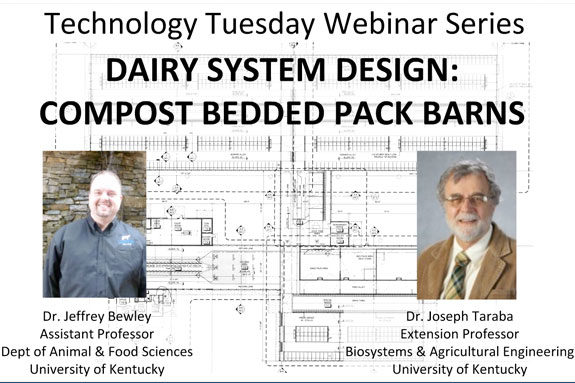On December 11, 2012, Jeffrey Bewley and Joseph Taraba from the University of Kentucky led a webinar on the topic of compost bedded pack barns. Throughout the hour-and-a-half long presentation, the presenters covered different areas relating to this type of system, such as the benefits, design considerations and costs. “It’s important to recognize upfront that the management of the system is the most important part to its success,” Bewley, assistant professor in the Department of Animal and Food Sciences, says.
Click here or on the image at right to view the webinar in a new window.
He explains that when he first looked into the idea of a compost bedded pack barn system, he was hesitant that it would work for dairy cows.
“I’ve changed my mind in the last few years, having worked with farmers that manage this system and manage it very well,” he says. “Like every housing system, it can be managed properly and create a great environment for cows and farmers, but I also think that if it’s mismanaged, it can be a very poor environment for cows.”
Bewley explains the idea behind this type of system came from Virginia dairy farmers looking for a different way of managing their animals.
The concept of this system is that it provides a loose housing environment where the animals have a large, open resting area and a softer lying surface. At the same time, the system also follows an intensively managed compost process.
Taraba, an extension professor in the Department of Biosystems and Agricultural Engineering, explained that when compared to a freestall barn using sand bedding, less capital would be spent for the recovery and recycling of sand, less time and money spent for the desludging of lagoons, and there would be less equipment wear from sand abrasion.
However, he does point out that with compost bedded barn systems, there is still the need for liquid waste disposal and the equipment used for this process.
Management considerations
To start a compost bedded pack, Bewley explains that 1.5 to two feet of bedding are required. The total amount of sawdust used to start a pack will depend on the size of the barn. It’s a significant investment just to get the sawdust in these barns in the beginning, he says.
Bewley recommends for producers to add new bedding every one to eight weeks, or when the pack starts looking moist.
More pack is added when it is wet and during the wintertime, as less heat is generated in the compost in these instances. He explains that the pack should also be cleaned out at least one to two times per year.
Taraba reviewed alternative sources that could be used in a compost bedded pack.
Sawdust is one the most commonly used bedding sources due to its ability to absorb more water. Taraba explains that a mixture of sawdust and shavings is ideal for a compost bedded pack.
“A lot of the success of the barn hinges on the availability and the cost of bedding,” Bewley adds.
When stirring the bedding material, Taraba explains that it is better to pull the tillage tool rather that push it, if a front-end loader is used. This reduces the compaction of the bedding and helps avoid lower temperature in the bedding.
“One of things we want to do is generate sufficient heat,” Taraba says.
The heat generated in the compost helps dry the bedding, controlling the moisture level of the pack. Three factors that can influence moisture level are the stirring of the bedding, the type of bedding used and the particle size of the bedding.
He adds that the pack needs to have a high porosity, in order for the oxygen level of the bedding to sustain the compost process.
Bewley and Taraba summarized some factors that can contribute to the failure of compost bedded pack barns. These include:
• Flaws in barn design
• Stocking density
• Inadequate or ineffective stirring
• Insufficient bedding volume
• Type of material used
• Compaction from tractors
Bewley also provided details from a compost study conducted from October 2010 to March 2011 on 43 dairy farms in Kentucky. He explains that feedback received from producers on compost bedded pack barn systems includes that the barns improved cow comfort and cow cleanliness, and that it was a low-maintenance system.
The webinar was presented as part of Penn State Extension’s Technology Tuesdays webinar series. According to Penn State Extension, this year’s webinar series will focus on dairy systems planning and building. The free online workshops are designed for dairy producers, employees and advisers. PD
To see additional details from the presentation, including recommendations for design, health and cost considerations, and to view the entire webinar, click here. To watch recordings of other past Technology Tuesday webinars, click here.

Dario Martinez
Editor
Progressive Dairyman magazine






